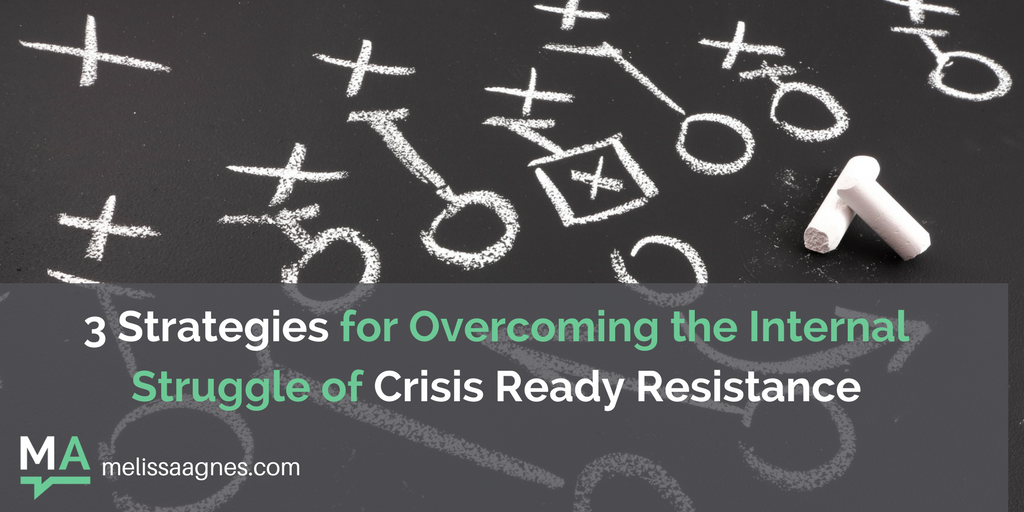
Image: cvm | Shutterstock
I recently received the following comment on a post I shared to social media:
Sometimes it’s just hard to start talking about crisis preparedness because no one wants to be involved in a negative event. When a conversation starts, following your guidelines is the key. But the starting point seems to be so difficult to reach!
This struggle is real. I see it all the time. Gaining internal buy-in from the right people to implement a crisis ready culture can sometimes feel like an uphill battle. Fortunately, there are ways to strategize around this, helping the right people become aware of the realities and susceptibilities of not being crisis ready and, ultimately, acquiring the support and buy-in required to take the first steps towards building brand invincibility.
 In my book, Crisis Ready–Building an Invincible Brand in an Uncertain World, I address this internal struggle by providing three strategic approaches that continue to work for me, when helping my clients acquire full consensus. The following is an excerpt taken from Crisis Ready (which is available for purchase on Amazon) to help you address this internal challenge, if this struggle is relatable to you.
In my book, Crisis Ready–Building an Invincible Brand in an Uncertain World, I address this internal struggle by providing three strategic approaches that continue to work for me, when helping my clients acquire full consensus. The following is an excerpt taken from Crisis Ready (which is available for purchase on Amazon) to help you address this internal challenge, if this struggle is relatable to you.
Leadership’s role in becoming crisis ready
In order to implement a crisis ready culture, let’s face it, the organization needs full buy-in from, and support of, leadership. Not only is culture implemented from the top down, but without this buy-in and support, resistance is bound to get in the way, which won’t help in mitigating (never mind managing) a crisis. So, let’s discuss some of the biggest, most common internal obstacles that organizations face when seeking that buy-in, along with some strategic steps you can take to overcome them. Whether you’re a member of the leadership team, or a manager or director seeking to gain full buy-in from leadership, the following will serve and support this effort.
There are several common reasons behind the resistance that many professionals experience, when trying to sell the need to be crisis ready. Depending on your organization and its culture, this resistance can stem from things like:
- Management wrongfully believes that the old ways of managing crises still apply and will continue to work for the organization.
- The organization feels immune to crises.
- Certain departments (e.g.: legal) or executives have a hard time releasing the reins and being open to the need to be proactive and communicate in a timely fashion in times of crisis.
- The organization lacks the necessary resources to dedicate to this type of initiative.
Do any of these sound familiar?
These internal blocks can be frustrating for team members who understand that the organization is vulnerable and insufficiently prepared to successfully manage crises. I’ve seen just how frustrating this can be for forward-thinking professionals. There are three ways to approach overcoming this internal obstacle and gaining the required buy-in. One or a combination of the following three approaches may work for you and your objectives, depending on the people you’re trying to sway.
APPROACH #1: ASK TWO IMPORTANT QUESTIONS
In chapter four we’ll discuss your organization’s high-risk scenarios, but before we get there, following is an exercise to consider undertaking with different members of your leadership team. This exercise will help you spark discussions and gain necessary awareness. The exercise is as follows:
Ask each member of management what type of risk or crisis scenario keeps them up at night. Then, using some of the crisis management challenges we discuss in chapter two, present them with the obstacles the organization would be faced with in the event of these scenarios. Ask them if they think the organization would be able to successfully overcome these challenges.
Each member of management will have a different crisis scenario in mind, depending on what his or her position and responsibilities are within the organization. For example, your head of HR may be worried about workplace violence or employee misconduct, while your Chief Information Officer will be thinking more about cybersecurity threats. For this reason, and to achieve the best results, I recommend conducting this exercise in a group setting, where it will be collaborative. Each person who raises their concerns will add to the last concern expressed, helping management realize that there are multiple risks and challenges that the organization may not necessarily be ready for.
APPROACH #2: EDUCATE (AND SCARE A LITTLE!)
As a crisis management advisor and keynote speaker, I’ve learned that there’s a beneficial way to use both of my skill sets to help educate management teams regarding today’s crisis management realities. Look at this as an internal keynote presentation for your management team, where the objective is to educate, provoke thought, and inspire action, ultimately getting you that buy-in.
This should be an interactive presentation (an hour or two long) that discusses the realities of today’s crisis management. Use real-world examples of organizations that have managed them well, as well as others who have failed. It should also provide the team with some simple steps that they could begin taking to implement a crisis ready culture, helping them realize that this objective is a realistic one to attain, rather than being an overwhelming endeavor that will consume all their time.
Oftentimes, bringing in an outside expert with real-world experience helps to bring a level of credibility that offers additional weight and support to your objectives. If this is an approach that might work with your team, following are some recommendations to help you hire the right professional.
- The person you hire should be a talented speaker with real-world crisis management and preparedness experience. The talented speaker aspect will make it an entertaining and engaging experience, while the real-world experience will bring the required credibility you’ll need to really make an impact.
- Make sure it’s not a sales pitch. Too often, I hear from clients that the consultants and/or speakers they hired before me used these opportunities to pitch and sell further services. Make sure this doesn’t happen to you. (If you happen to be a consultant reading this, don’t do this!) It will only detract from the important message and impact you’re aiming to achieve. Instead, this should be viewed as a worthy project or deliverable in and of itself. Not a way to get more business! The professional you choose should be passionate about delivering this message. If they do it well, maybe you’ll choose to hire them for more work and maybe you won’t. Their goal with this presentation should be to help you achieve your internal objectives, nothing more.
APPROACH #3: TEST THE TEAM
If management feels they’re ready to handle a crisis, then why not put them—and your current crisis plan—to the test? While crisis simulations make great training exercises once an organization has developed their crisis ready program, they can also be a stimulating way to help you gain that buy-in. (Spoiler alert! We will discuss crisis simulations in detail in chapter nine, where I will help you develop a realistic scenario and successfully conduct this wonderful exercise.)
A crisis simulation is an exercise that feels as though a real crisis is unfolding, even though it takes place in a controlled and safe environment. During this exercise, the crisis management team is given a few hours to successfully (or unsuccessfully) manage the unfolding crisis. This type of exercise offers more than a traditional tabletop. Unlike a traditional tabletop where a scenario is presented and then discussed, a simulation is an interactive exercise where the team encounters the real-world challenges we’ve highlighted throughout chapter two, and must get up and take the right actions to manage the unfolding, simulated crisis.
This type of exercise can be one of the most effective ways to gain buy-in, due to its level of realism. The scenario and its challenges are realistic, and the results and impact are immediately felt. In my experience, it’s always been a highly effective exercise that helps to educate, create awareness, and motivate next steps!
***********************************************************************************************************
Crisis Ready.
The book to help you build an INVINCIBLE brand.
By Melissa Agnes
Order copies for you and your team on amazon, or contact info@mascotbooks.com for special bulk pricing.

Author of Crisis Ready: Building an Invincible Brand in an Uncertain World, Melissa Agnes is a leading authority on crisis preparedness, reputation management, and brand protection. Agnes is a coveted keynote speaker, commentator, and advisor to some of today’s leading organizations faced with the greatest risks. Learn more about Melissa and her work here.

